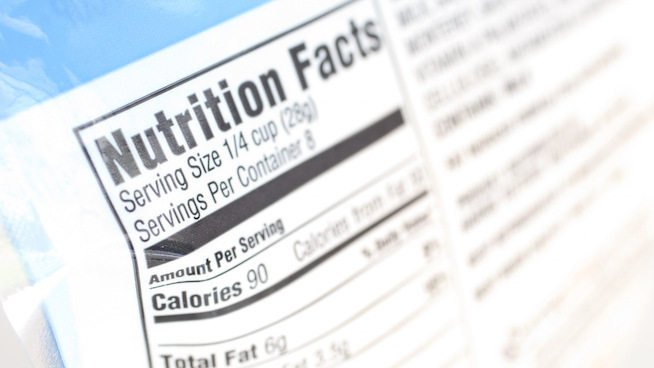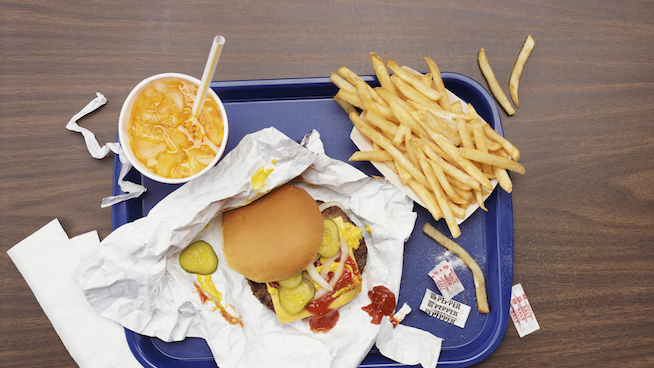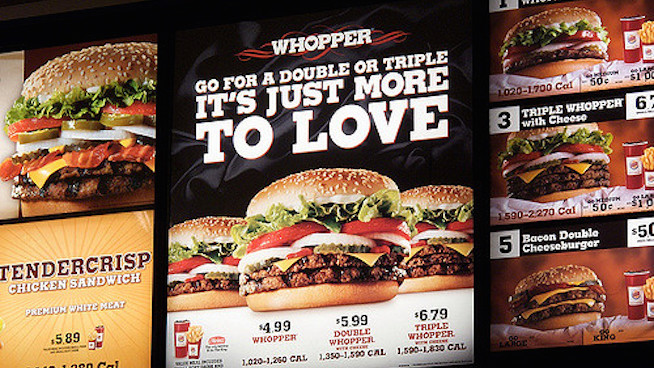As obesity rates have soared in recent years, food labeling has become a big focus in America.
In May, rules for a new nutrition facts label were finalized by the FDA. The changes include requirements to list the amount of added sugars in a product and to make serving sizes more prominent. In July, Congress passed a bill to require producers of foods that contain genetically modified organisms (GMOs) to list that fact on their packaging. Next year, the FDA is expected to begin enforcing menu labeling rules that passed as part of the 2010 health care overhaul. The rules will require restaurants and other businesses that sell prepared food and that have 20 or more locations to post the calorie content of the food clearly and conspicuously on menus and displays.
The logic behind the legislation is straightforward—many Americans eat junk, and they’re unhealthy because of it. If we label the junk, it should help them become aware of the fact that it’s garbage and eat less of it. Right? It makes sense in theory, but it might not be so simple. Here’s why food labels might not be helping our nationwide battle to eat better.
Hiding in Plain Sight

Those who believe in increased food labeling protocols have their hearts in the right place, but several studies have found that labeling might not be all that effective.
A recent study from New York University found that labeling calories on the menu at fast food restaurants had a negligible effect on customer choices. Excerpts from the Science Daily summary of the study:
Researchers used data collected in Philadelphia shortly after calorie labeling went into effect in the city in 2008. They analyzed responses from 699 consumers who completed point-of-purchase surveys at 15 fast-food restaurants throughout Philadelphia, as well as responses from 702 phone surveys of the city’s residents. The researchers found that only a small fraction of fast-food eaters—as little as 8 percent—are likely to make healthy choices as a result of current calorie labeling.
It was not the only study to find such results. A 2011 study published in the American Journal of Preventative Medicine found that mandatory menu calorie-labeling in King County, Washington for restaurant chains with 15 or more locations had no impact on customer choices.
RELATED: Is the FDA’s New Nutrition Label Any Good? Experts Weigh In
“No impact of the regulation on purchasing behavior was found. Trends in transactions and calories per transaction did not vary between control and intervention locations after the law was enacted,” wrote the study’s authors.
We’re not saying that all food labeling studies have similar results. For example, a 2010 study published in the American Journal of Public Health found that diners in a 303-participant dinner consumed fewer calories when ordering from a menu with calorie labels. That effect was amplified even more when the labels also included a daily caloric requirement.
Certainly the research is conflicting. Increased food labeling might seem like a foolproof way to get people to eat healthier, but that doesn’t seem to be the case.
Old Habits Die Hard

The long-term impact of health-conscious-motivated food labeling might not be as positive as some have made it out to be.
But why might things like menu calorie-counts make no significant difference in the way people eat?
People who are already concerned with their health and nutrition are the ones most likely to pay attention to food labeling. Those who are unconcerned with their nutrition aren’t likely to be significantly influenced by the labeling. They already know that what they’re eating isn’t good for them, but they don’t really care.
RELATED: Study Finds That Living Near Fast Food Increases Risk of Obesity
“Stuff like putting calories on a restaurant menu is assuming that people make decisions based on the knowledge they have. A lot of times, lack of knowledge isn’t our limiting factor,” says Ryan Andrews, nutrition coach at Precision Nutrition. “Most people, most adults, have enough basic knowledge about nutrition that would allow them to make major strides in their health if they wanted to right now. If you took 50 people to the grocery store and asked them to pick out five nutritious foods, I’m confident the vast majority could do it. Nationally, people understand they should be eating lots of fruits and vegetables every day. But most don’t do it.”
But it’s not just about the motivation (or lack thereof) to eat healthy. The foods that legislators are hoping people will eat less of due to increased food labeling are, in many cases, addictive. Eric Finkelstein, an associate professor at Duke University’s Global Health Institute, spoke to Scientific American about the aforementioned 2011 study published in the AJPM: He said:
“The fact that it was zero change was a little surprising. This information just doesn’t change their behavior. I think fast-food customers who are busy and interested in having a nice meal are just not that interested in the calorie posting. I think super healthy people just don’t go to [fast food restaurants]. The simple story is: consumers knew what they like, you gave them information, and they still buy it. It’s actually not an irrational decision—it’s got all the ingredients that people crave: sugar, salt, fats. Once you buy it and you start eating it, it’s quite difficult to stop.”
Research backs up Finkelstein’s sentiments. A 2011 research review published in Current Drug Abuse Reviews found that fast food possesses a number of characteristics that make it more addictive than well-balanced meals. These characteristics include high fat, salt, caffeine and sugar content. “While the concept of fast food addiction remains to be proven, these findings support the role of fast food as a potentially addictive substance that is most likely to create dependence in vulnerable populations,” the study’s authors write.
RELATED: 5 Ways Junk Food Messes With Your Head
A 2013 study discovered that Oreos and drugs such as cocaine and morphine have similar effects on the brains of rats. The study’s authors wrote, “Rats formed an equally strong association between the pleasurable effects of eating Oreos and a specific environment as they did between cocaine or morphine and a specific environment. [The researchers] also found that eating cookies activated more neurons in the brain’s ‘pleasure center’ than exposure to drugs of abuse.”
Money Talks

So if current food labeling measures won’t be noticeably effective in getting people to eat better, what will?
One alternative to increased food labeling is to place a higher tax on foods that are closely linked to diseases like diabetes and obesity. The city of Berkeley, California was the first U.S. city to pass a “soda tax.” In March of 2015, the tax went into effect. Customers must pay an additional $0.01 per fluid ounce of sugar-sweetened beverages. A recent study published in the American Journal of Public Health found that consumption of sugar-sweetened beverages in Berkeley decreased by 21 percent since the tax. Water consumption also went up—by 63 percent. During that same time span, San Francisco and Oakland—two cities without soda taxes—saw a 4 percent increase in sugar-sweetened beverage consumption.
“Most people seem to know if they’re overweight, and that hasn’t seemed to change their behaviors. Obese people certainly know that their weight is increasing their risk of poor health—they actually overestimate the mortality risks of obesity. I think information alone is not going to change people’s behavior and get them to lose weight. If you look back at tobacco, the truth is that most of the change in smoking was due to cigarette taxes—the information campaigns had only a marginal effect. I think prices have a more salient effect when it comes to these types of behaviors,” Finkelstein says.
RELATED: How Can Zero-Calorie Diet Soda Be Bad For You?
Andrews believes that environmentally-centric labeling could help encourage people to think about a food’s impact on the world, thereby helping them realize that their choices affect others besides themselves. “Carbon footprint, country of origin, water use, farm labor conditions and animal welfare standards—I think if more people had access to this kind of information when selecting foods, they’d be willing to make some modifications,” Andrews says. “More than anything, I think Amercians are just disconnected from food and where it comes from. There’s very little respect for food. It’s just this thing that pops up in a market or gas station and little thought goes into it.”
RECOMMENDED FOR YOU
MOST POPULAR
As obesity rates have soared in recent years, food labeling has become a big focus in America.
In May, rules for a new nutrition facts label were finalized by the FDA. The changes include requirements to list the amount of added sugars in a product and to make serving sizes more prominent. In July, Congress passed a bill to require producers of foods that contain genetically modified organisms (GMOs) to list that fact on their packaging. Next year, the FDA is expected to begin enforcing menu labeling rules that passed as part of the 2010 health care overhaul. The rules will require restaurants and other businesses that sell prepared food and that have 20 or more locations to post the calorie content of the food clearly and conspicuously on menus and displays.
The logic behind the legislation is straightforward—many Americans eat junk, and they’re unhealthy because of it. If we label the junk, it should help them become aware of the fact that it’s garbage and eat less of it. Right? It makes sense in theory, but it might not be so simple. Here’s why food labels might not be helping our nationwide battle to eat better.
Hiding in Plain Sight

Those who believe in increased food labeling protocols have their hearts in the right place, but several studies have found that labeling might not be all that effective.
A recent study from New York University found that labeling calories on the menu at fast food restaurants had a negligible effect on customer choices. Excerpts from the Science Daily summary of the study:
Researchers used data collected in Philadelphia shortly after calorie labeling went into effect in the city in 2008. They analyzed responses from 699 consumers who completed point-of-purchase surveys at 15 fast-food restaurants throughout Philadelphia, as well as responses from 702 phone surveys of the city’s residents. The researchers found that only a small fraction of fast-food eaters—as little as 8 percent—are likely to make healthy choices as a result of current calorie labeling.
It was not the only study to find such results. A 2011 study published in the American Journal of Preventative Medicine found that mandatory menu calorie-labeling in King County, Washington for restaurant chains with 15 or more locations had no impact on customer choices.
RELATED: Is the FDA’s New Nutrition Label Any Good? Experts Weigh In
“No impact of the regulation on purchasing behavior was found. Trends in transactions and calories per transaction did not vary between control and intervention locations after the law was enacted,” wrote the study’s authors.
We’re not saying that all food labeling studies have similar results. For example, a 2010 study published in the American Journal of Public Health found that diners in a 303-participant dinner consumed fewer calories when ordering from a menu with calorie labels. That effect was amplified even more when the labels also included a daily caloric requirement.
Certainly the research is conflicting. Increased food labeling might seem like a foolproof way to get people to eat healthier, but that doesn’t seem to be the case.
Old Habits Die Hard

The long-term impact of health-conscious-motivated food labeling might not be as positive as some have made it out to be.
But why might things like menu calorie-counts make no significant difference in the way people eat?
People who are already concerned with their health and nutrition are the ones most likely to pay attention to food labeling. Those who are unconcerned with their nutrition aren’t likely to be significantly influenced by the labeling. They already know that what they’re eating isn’t good for them, but they don’t really care.
RELATED: Study Finds That Living Near Fast Food Increases Risk of Obesity
“Stuff like putting calories on a restaurant menu is assuming that people make decisions based on the knowledge they have. A lot of times, lack of knowledge isn’t our limiting factor,” says Ryan Andrews, nutrition coach at Precision Nutrition. “Most people, most adults, have enough basic knowledge about nutrition that would allow them to make major strides in their health if they wanted to right now. If you took 50 people to the grocery store and asked them to pick out five nutritious foods, I’m confident the vast majority could do it. Nationally, people understand they should be eating lots of fruits and vegetables every day. But most don’t do it.”
But it’s not just about the motivation (or lack thereof) to eat healthy. The foods that legislators are hoping people will eat less of due to increased food labeling are, in many cases, addictive. Eric Finkelstein, an associate professor at Duke University’s Global Health Institute, spoke to Scientific American about the aforementioned 2011 study published in the AJPM: He said:
“The fact that it was zero change was a little surprising. This information just doesn’t change their behavior. I think fast-food customers who are busy and interested in having a nice meal are just not that interested in the calorie posting. I think super healthy people just don’t go to [fast food restaurants]. The simple story is: consumers knew what they like, you gave them information, and they still buy it. It’s actually not an irrational decision—it’s got all the ingredients that people crave: sugar, salt, fats. Once you buy it and you start eating it, it’s quite difficult to stop.”
Research backs up Finkelstein’s sentiments. A 2011 research review published in Current Drug Abuse Reviews found that fast food possesses a number of characteristics that make it more addictive than well-balanced meals. These characteristics include high fat, salt, caffeine and sugar content. “While the concept of fast food addiction remains to be proven, these findings support the role of fast food as a potentially addictive substance that is most likely to create dependence in vulnerable populations,” the study’s authors write.
RELATED: 5 Ways Junk Food Messes With Your Head
A 2013 study discovered that Oreos and drugs such as cocaine and morphine have similar effects on the brains of rats. The study’s authors wrote, “Rats formed an equally strong association between the pleasurable effects of eating Oreos and a specific environment as they did between cocaine or morphine and a specific environment. [The researchers] also found that eating cookies activated more neurons in the brain’s ‘pleasure center’ than exposure to drugs of abuse.”
Money Talks

So if current food labeling measures won’t be noticeably effective in getting people to eat better, what will?
One alternative to increased food labeling is to place a higher tax on foods that are closely linked to diseases like diabetes and obesity. The city of Berkeley, California was the first U.S. city to pass a “soda tax.” In March of 2015, the tax went into effect. Customers must pay an additional $0.01 per fluid ounce of sugar-sweetened beverages. A recent study published in the American Journal of Public Health found that consumption of sugar-sweetened beverages in Berkeley decreased by 21 percent since the tax. Water consumption also went up—by 63 percent. During that same time span, San Francisco and Oakland—two cities without soda taxes—saw a 4 percent increase in sugar-sweetened beverage consumption.
“Most people seem to know if they’re overweight, and that hasn’t seemed to change their behaviors. Obese people certainly know that their weight is increasing their risk of poor health—they actually overestimate the mortality risks of obesity. I think information alone is not going to change people’s behavior and get them to lose weight. If you look back at tobacco, the truth is that most of the change in smoking was due to cigarette taxes—the information campaigns had only a marginal effect. I think prices have a more salient effect when it comes to these types of behaviors,” Finkelstein says.
RELATED: How Can Zero-Calorie Diet Soda Be Bad For You?
Andrews believes that environmentally-centric labeling could help encourage people to think about a food’s impact on the world, thereby helping them realize that their choices affect others besides themselves. “Carbon footprint, country of origin, water use, farm labor conditions and animal welfare standards—I think if more people had access to this kind of information when selecting foods, they’d be willing to make some modifications,” Andrews says. “More than anything, I think Amercians are just disconnected from food and where it comes from. There’s very little respect for food. It’s just this thing that pops up in a market or gas station and little thought goes into it.”











